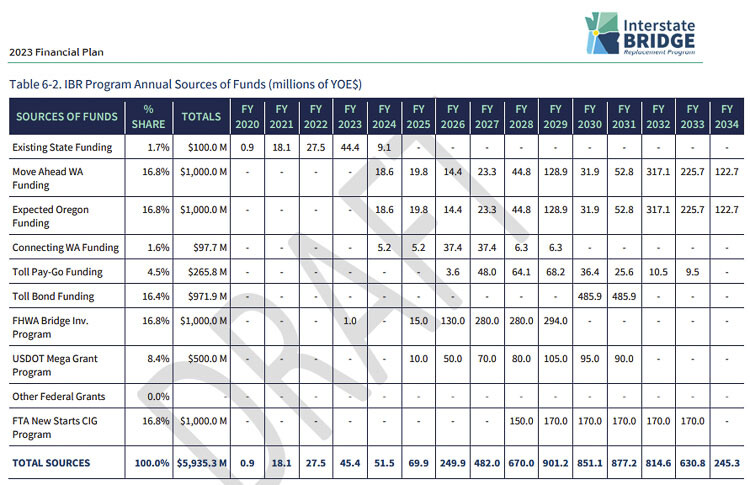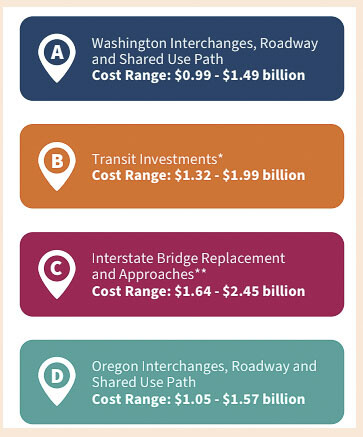Is Oregon’s promise of $750 million in the next 3 biennium acceptable to feds?
John Ley
for Clark County Today
On the last day of their 2023 legislative session, Oregon lawmakers allocated $250 million to fund the Interstate Bridge Replacement Program (IBR). They also promised to pass an additional $750 million in future funding for the next three biennial budgets. Is that plan acceptable to the federal agencies the IBR is seeking funding from?
The IBR team is telling the community that the cost of the I-5 Bridge replacement project will be between $5 billion and $7.5 billion. The hope is it will likely be about $6 billion, with the federal government making a sizable contribution in the range of $1.5 billion to $2.5 billion, tolls contributing about $1.2 billion, and Oregon and Washington paying for the rest.
Funding the largest public works project in regional history is of importance to Southwest Washington citizens because over 75,000 residents work in Oregon. Additionally, many people receive medical care in Portland, especially at OHSU or the Portland Veterans Administration Health Center.
Tolling remains a significant concern for Southwest Washington residents as Oregon officials plan to add tolls to all area highways and freeways, via their Regional Mobility Pricing Project. This is in addition to IBR tolling and tolls on the I-205 Abernethy Bridge and Tualatin Bridge. Portland economist Joe Cortright revealed earlier this year those combined tolls could run between $28 and $31 a day when traveling from Vancouver to Wilsonville.

Earlier this year, Oregon Governor Tina Kotek issued an Executive Order telling the Oregon Department of Transportation (ODOT) to not begin collecting tolls until at least January 1, 2026. The day after the conclusion of the Oregon legislature, ODOT revealed a significant funding shortfall of roughly $3 billion, part of which was attributed to the delay in collecting tolls. ODOT has subsequently delayed the second phase of the I-205 project, the I-5 Rose Quarter project, and the Wilsonville Boone Bridge project..
The Washington State Legislature has allocated $1.1 billion in funding. Last month, the Oregon legislature committed $250 million from its biennial budget for the IBR and lawmakers they would contribute an additional $250 million for each of the next three biennial budgets, through 2030.
Clark County Today reached out to the IBR team with multiple questions about the project, including the following:
• Question No. 1 – Oregon has now made a “down payment” of $250 million towards its $1 billion contribution for the IBR. This will be $250 million coming from the General Fund revenues/budget. Lawmakers have expressed their desire to contribute an additional $250 million in each biennium for the next three budget cycles — 2025, 2027, and 2029.
The IBR has noted that federal funds are “the last in” when it comes to seeking federal dollars for a project of this magnitude. Given that the IBR actually is only getting $250 million from Oregon at this time, with an IOU for the next three bienniums, will the IBR be able to seek federal dollars from all federal programs at this time?
The IBR hopes to receive between $1.5 billion to $2.5 billion in funds from several separate programs, some from the Federal Highway Administration (FHWA) and others from the Federal Transit Administration (FTA). Does Oregon’s “downpayment” allow you to receive all the funds you’re hoping for at this time? Or will Oregon need to provide additional funds in 2025 in order to qualify for all the federal programs?
• Question No. 2 – The IBR has stated that the FTA requires $300 million to come from the “local” contribution for the transit component of the project before they will commit their funds. Will that $300 million be split evenly between Oregon and Washington? If Oregon allocated $150 million to the transit component of the IBR, that only leaves $100 million of the $250 million, to go to the rest of the IBR project. Will the FHWA consider Oregon’s $100 million “enough” of a local contribution to qualify for ALL the FHWA funding programs you will be applying for?

Frank Green, IBR assistant program administrator provided a response to the two questions above.
On June 25, the Oregon State Legislature passed legislation that committed $1 billion for the Interstate Bridge Replacement program, matching the $1 billion commitment made by Washington in the 2022 session. For budgeting and financial purposes, the full $1 billion in funding is considered committed with an identified revenue stream, upon Governor Kotek’s signature. Having the non-federal matching funds committed in both Oregon and Washington demonstrates the strong bi-state support needed to complete these critical multimodal investments and increases our competitiveness as the IBR program seeks to maximize federal grant funding.
The program anticipates applying for approximately $2.5-3 billion across multiple federal funding sources. We are confident that our multimodal program is well positioned to compete in the identified grant programs, which include the U.S. Department of Transportation Mega Grant, the Federal Highway Administration Bridge Investment Program and the Federal Transit Administration Capital Improvement Grant.
The IBR program is currently developing application materials for the Mega Grant based on recently released grant requirements and will submit in August. (More information regarding Mega Grant eligibility is available here). Requirements for the Bridge Investment Program grant are anticipated to be released later this summer. It is anticipated that grant award recipients for these two programs will be announced late this year or early next year.
The FTA Capital Improvement Grant has a separate and distinct process with multiple phases over several years. The program has submitted our request to FTA to begin this multiyear process and will continue to address the requirements of each phase. (FTA CIG guidance regarding transit funding requirements can be found in this FTA January 2023 policy guidance document.)
As a multimodal program, for the CIG program we are able to count all local and state funding contributions that fund the overall program, not just transit investments, to demonstrate local matching funds. Existing state funding contributions and tolling authorization in both states provides the local contributions necessary for the grant programs we anticipate pursuing.
More information can be found on our Cost, Funding & Economic Benefits web page or in the 2023 Financial Plan.
The Oregon legislature funded $5.3 billion in statewide transportation projects in 2017 via HB 2017. Six years later, exploding costs and questionable funding have created a $3 billion shortfall according to ODOT. Multiple Portland area projects are now on hold or indefinitely “paused”.
The Rose Quarter cost estimate has quadrupled, and many other ODOT programs have doubled in cost. Before a single shovel of dirt has been turned, the cost of the IBR has doubled. Tolling is now in question in Oregon.
Will the Federal Highway Administration or the Federal Transit Administration look at this track record and provide funding at this time? Citizens will be watching closely.




